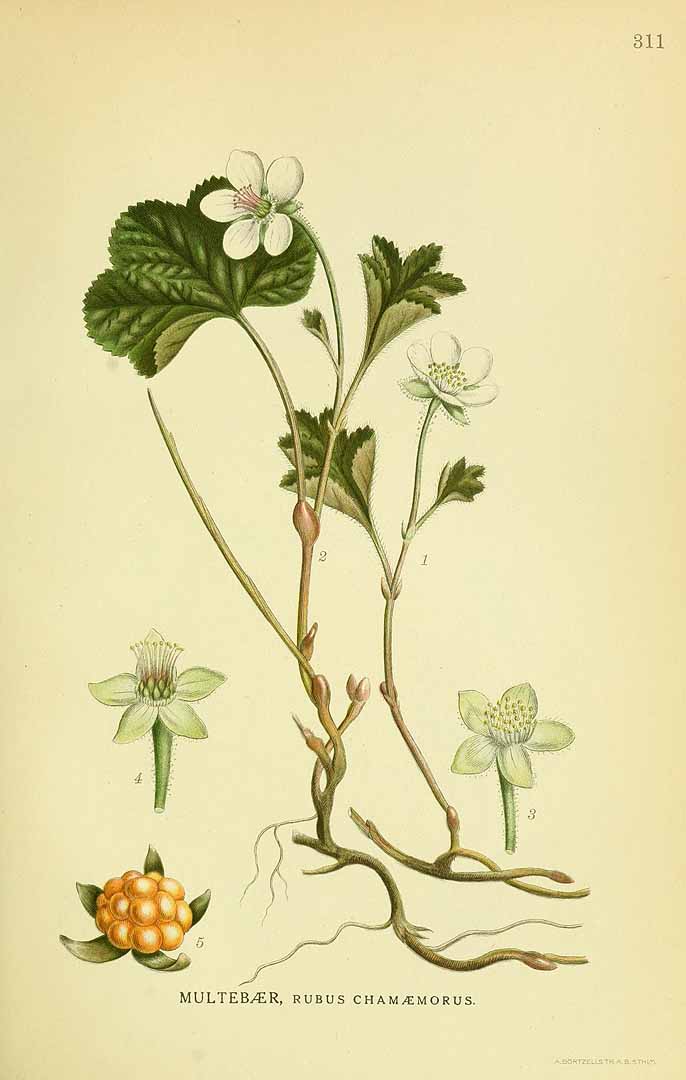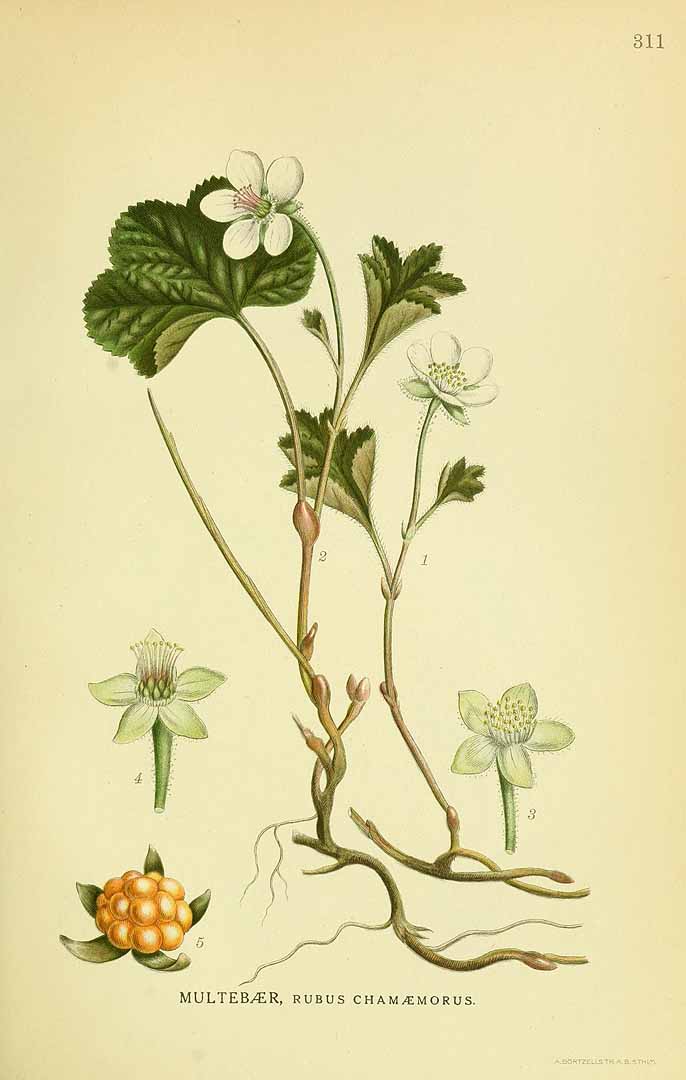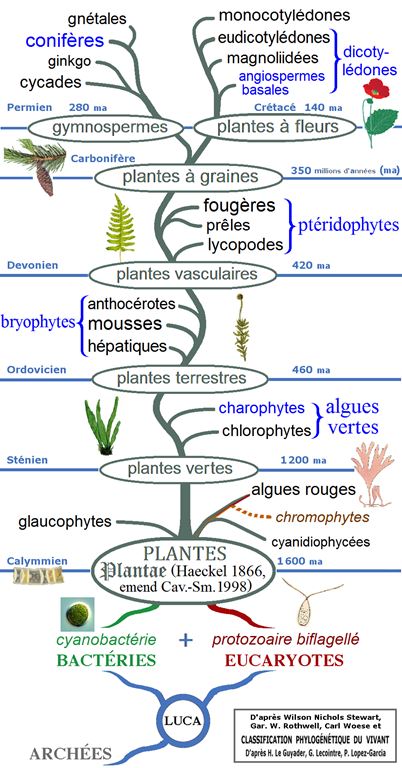Rubus chamaemorus

zone 2-4
Une herbe rampante. Il continue de croître d'année en année. Il pousse de 8 à 25 cm de haut. Les jeunes pousses proviennent du rhizome ou d'un mince porte-greffe rampant. ... (traduction automatique)
→suite
Rubus chamaemorus 

Note alimentaire ![]()
![]()
![]()
![]()
Une herbe rampante. Il continue de croître d'année en année. Il pousse de 8 à 25 cm de haut. Les jeunes pousses proviennent du rhizome ou d'un mince porte-greffe rampant. Les feuilles mesurent 5 à 8 cm de diamètre. Les plantes sont séparément mâles et femelles. Les fleurs se produisent séparément. Les fleurs... (traduction automatique) →suite
Pas d'autre illustration
pour le moment 😕
Classification
- Classique : en haut de l\'écran, sous le coeur.
- Phylogénétique :
- Clade 4 : Angiospermes ;
- Clade 3 : Dicotylédones_vraies ;
- Clade 2 : Rosidées ;
- Clade 1 : Fabidées ;
- Ordre APN : Rosales ;
- Famille APN : Rosaceae ;
Illustration : cet arbre phylogénétique des plantes montre les principaux clades et groupes traditionnels (monophylétiques en noir et paraphylétiques en bleu).
Dénominations
✖- Nom botanique : Rubus chamaemorus L. (1753)
- Noms anglais et locaux : cloudberry
Description et culture
✖- dont infos de "FOOD PLANTS INTERNATIONAL" :
Description :
Une herbe rampante. Il continue de croître d'année en année. Il pousse de 8 à 25 cm de haut. Les jeunes pousses proviennent du rhizome ou d'un mince porte-greffe rampant. Les feuilles mesurent 5 à 8 cm de diamètre. Les plantes sont séparément mâles et femelles. Les fleurs se produisent séparément. Les fleurs sont blanches et mesurent 4 cm de diamètre. Il n'y a souvent que 4 pétales. Les fruits sont orange rougeâtre à jaune. Ils sont comestibles{{{0(+x) (traduction automatique).
Original : A creeping herb. It keeps growing from year to year. It grows 8-25 cm high. Young shoots arise from the rhizome or thin creeping rootstock. The leaves are 5-8 cm across. Plants are separately male and female. The flowers occur singly. The flowers are white and 4 cm across. There are often only 4 petals. The fruit are reddish-orange to yellow. They are edible{{{0(+x).
 Consommation (rapports de comestibilité, parties utilisables et usages alimentaires correspondants)
Consommation (rapports de comestibilité, parties utilisables et usages alimentaires correspondants)
✖
-fruits - crus ou cuits ; aigre mais délicieux, le fruit peut être mangé tel quel ou cuit, utilisé dans les conserves, les tartes, etc. ; riche en vitamine C ; le fruit sucré a un goût de pommes au four{{{5(+) ;
-fleurs - crues ;
-les feuilles fraîches
Partie testée :
/| Taux d'humidité | Énergie (kj) | Énergie (kcal) | Protéines (g) |
|---|---|---|---|
| / | / | / | / |
| Pro- vitamines A (µg) |
Vitamines C (mg) | Fer (mg) | Zinc (mg) |
| / | / | / | / |
 Risques et précautions à prendre
Risques et précautions à prendre
✖
néant, inconnus ou indéterminés.
Galerie(s)
✖
Par Lindman, C.A.M., Bilder ur Nordens Flora Bilder Nordens Fl. vol. 2 (1922) t. 311 , via plantillustrations
Autres infos
✖dont infos de "FOOD PLANTS INTERNATIONAL" :
Statut :
Il est récolté par les peuples autochtones des régions polaires. (Sami et Inuits) C'est un aliment important. Il est récolté commercialement{{{0(+x) (traduction automatique).
Original : It is harvested by indigenous people in polar regions. (Sami and Inuits) It is a significant food. It is harvested commercially{{{0(+x).
Distribution :
C'est une plante tempérée froide. Il peut pousser dans les climats froids, y compris le cercle arctique. Il pousse dans les tourbières acides et les toundras de tourbe. Il pousse dans les marais. En Chine, c'est dans les provinces du nord. Il convient aux zones de rusticité des plantes 2-5{{{0(+x) (traduction automatique).
Original : It is a cold temperate plant. It can grow in cold climates including the Arctic circle. It grows on acidic bog and peat tundras. It grows in swamps. In China it is in the northern provinces. It suits plant hardiness zones 2-5{{{0(+x).
Localisation :
Alaska, Arctique, Asie, Australie, Biélorussie, Grande-Bretagne, Canada, Chine, République tchèque, Danemark, Estonie, Europe, Finlande, Allemagne, Irlande, Japon, Corée, Lettonie, Lituanie, Amérique du Nord, Norvège, Pologne, Russie, Scandinavie, Sibérie, Slovaquie, Suède, USA{{{0(+x) (traduction automatique).
Original : Alaska, Arctic, Asia, Australia, Belarus, Britain, Canada, China, Czech Republic, Denmark, Estonia, Europe, Finland, Germany, Ireland, Japan, Korea, Latvia, Lithuania, North America, Norway, Poland, Russia, Scandinavia, Siberia, Slovakia, Sweden, USA{{{0(+x).
Notes :
Il existe environ 250 espèces de Rubus. Ils sont riches en vitamine C{{{0(+x) (traduction automatique).
Original : There are about 250 Rubus species. They are high in Vitamin C{{{0(+x).
Rusticité (résistance face au froid/gel, climat)
✖zone 2-4
Liens, sources et/ou références
✖Sources et/ou références :
5"Plants For A Future" (en anglais) ;
dont classification : "The Plant List" (en anglais) ;
Recherche de/pour :
- "Rubus chamaemorus" sur Google (pages et
images) ;
INPI (en anglais) ;
TROPICOS (en anglais) ;
Tela Botanica ;
Pl@ntNet ;
Pl@ntUse ;
- "Rubus chamaemorus" sur Google (pages et
images) ;
INPI (en anglais) ;
TROPICOS (en anglais) ;
Tela Botanica ;
Pl@ntNet ;
Pl@ntUse ;
Espèces du même genre (Rubus)
✖50 taxons (sur 346)
- Rubus abbrevians
- Rubus abchaziensis
- Rubus aboriginum
- Rubus acanthophyllus
- Rubus acaulis
- Rubus acer
- Rubus aculeatissimus
- Rubus acuminatus
- Rubus adenophorus
- Rubus adenothallus
- Rubus adenotrichus
- Rubus aethiopicus
- Rubus affinis
- Rubus alaskensis
- Rubus alceifolius Poir. (Vigne marronne)
- Rubus alexeterius
- Rubus allegheniensis
- Rubus almus
- Rubus alnifoliatus
- Rubus alpestris
- Rubus amabilis
- Rubus ampelinus
- Rubus amphidasys
- Rubus apetalus
- Rubus archboldianus
- Rubus arcticus L. (Framboisier arctique)
- Rubus argutus
- Rubus arizonensis
- Rubus arizonicus
- Rubus armeniacus Focke (Mûre de l'himalaya (tp*))
- Rubus assamensis
- Rubus audax
- Rubus aurantiacus
- Rubus australis
- Rubus avipes
- Rubus azuayensis
- Rubus baileyanus
- Rubus barbatus
- Rubus barberi
- Rubus bellobatus
- Rubus benguetensis
- Rubus biflorus
- Rubus bifrons
- Rubus binatus
- Rubus blepharoneurus
- Rubus bloxamii
- Rubus bogotensis
- Rubus boliviensis
- Rubus brasiliensis
- Rubus brassii
- ...
Espèces de la même famille (Rosaceae)
✖50 taxons (sur 1223)
- Acaena anserinifolia (Forst. & Forst.f.) Druce
- Agrimonia coreana
- Agrimonia eupatoria L. (Aigremoine eupatoire)
- Agrimonia odorata
- Agrimonia pilosa
- Alchemilla alpina
- Alchemilla conjuncta
- Alchemilla fissa
- Alchemilla glabra
- Alchemilla hybrida
- Alchemilla mollis
- Alchemilla plicatula
- Alchemilla splendens
- Alchemilla vulgaris L. (Alchémille commune)
- Alchemilla xanthoclora
- Amelanchier alnifolia (Nutt.) Nutt. ex M. Roem. (Amélanchier à feuilles d'aulne)
- Amelanchier amabilis
- Amelanchier arborea
- Amelanchier asiatica
- Amelanchier bartramiana
- Amelanchier basalticola
- Amelanchier canadensis (L.) Medik. (Amélanchier du canada)
- Amelanchier confusa
- Amelanchier cretica
- Amelanchier cusickii
- Amelanchier humilis
- Amelanchier huroensis
- Amelanchier interior
- Amelanchier intermedia
- Amelanchier laevis Wiegand (Amélanchier glabre)
- Amelanchier lamarckii F. G. Schroed. (Amélanchier de lamarck)
- Amelanchier oblongifolia
- Amelanchier obovalis
- Amelanchier obovata
- Amelanchier ovalis Medik. (Amélanchier à feuilles ovales)
- Amelanchier pallida
- Amelanchier parviflora
- Amelanchier pumila
- Amelanchier sanguinea
- Amelanchier spicata
- Amelanchier stolonifera Wiegand
- Amelanchier utahensis
- Amelanchier weigandii
- Amelanchier x grandiflora Rehder
- Amelanchier x grandiflora
- Amelasorbus jackii
- Amygdalus andersonii
- Amygdalus communis
- Amygdalus graeca
- Amygdalus lycioides
- ...



